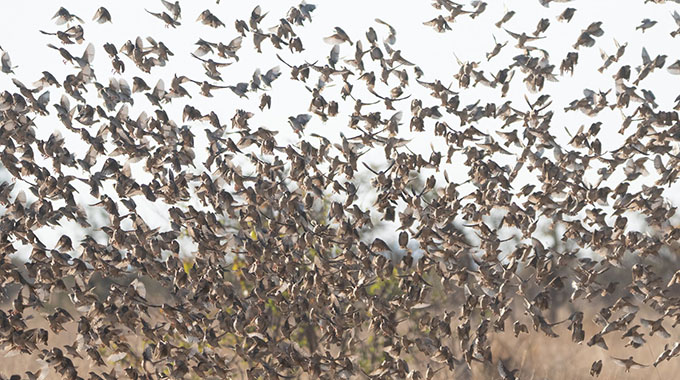EDITORIAL COMMENT: Let’s go beyond just exterminating quelea birds

One effect of the rapid growth in the size of the wheat crop and planting of more traditional grains is that there is a lot more food for quelea birds, and considering how fast this pest can breed far more chance of greater damage.
The most effective way of controlling this pest is to spray their huge roosts, sometimes containing over 1 million birds and occasionally even multimillion numbers.
Using fixed wing aircraft or helicopters is expensive, and in any case the noise of the engines can alarm the roost and allow many birds to escape.
Hand sprayers often find it near impossible to reach some of the roosts, since the birds do not as a matter of course build their roosts next to roads and paths, usually preferring the less accessible areas for greater safety.
So the purchase of 10 new drones with their 40 litre tanks will make a great difference, allowing more roosts to be sprayed at lower cost and so reducing the danger to the record wheat harvest and future harvests of traditional grain.
The addition of easily deployed and economical aerial spraying, with the ground crews not being stood down but instead reinforced by the drones, shows that the Ministry of Lands, Agriculture, Fisheries, Water and Rural Development is both innovative and responsive, and responsive in a way that uses every dollar in the ministry budget effectively.
We need to keep this feathered pest until strict control and this, regrettably, means killing as many as we can. There is no danger of extinction. Quelea are considered to have the largest populations of any bird species. The huge flocks that we can see these days largely arose from the extra food that farmers made available.
Quelea are small-seed eaters, basically eating grass seeds. In the days when there was no farming, and even when populations were sufficiently low that there was not much farming, huge surges in population were unlikely.
Too many birds died of starvation in winter before they could breed. Now, unless we are careful, our wheat crops will keep even more alive.
They have largely replaced the locust as the greatest danger to certain crops. The countries of East and Southern Africa managed to beat the locust menace with a major campaign that at its height had a fair number of aircraft and a lot of ground support.
Those huge hosts of locusts were killed off before they could cause havoc, and eventually the numbers were too low to trigger explosive breeding.
Quelea control uses many of the lessons learned from the locust days, including compulsory notification by land holders and farmers of quelea roosts. It is all very well to be able to control quelea, but those ground crews and now the drones need to know where the roosts are, and need to know promptly before the birds strip a field of mhunga or wheat.
The sooner the teams and the drones are deployed the less damage will be done by some gigantic flock, so everyone needs to be involved and needs to take their responsibilities seriously.
One area where some innovation is needed is converting quelea from a menace to a resource.
In the early 1980s one somewhat maverick officer in the Government department that developed into ZimParks started pressing this idea. He noticed that small finches were eaten whole, with gusto, in southern Europe as a snack or with half a dozen birds making up a portion for a full meal.
He wondered about the possibility of converting at least some of Zimbabwe’s quelea to snacks and dinners, and even had some queleas canned. One problem was the queleatox, the poison used to kill the quelea, which made them unfit for human consumption, at least by law, even though this poison breaks down very quickly.
The officer was quite happy personally to eat a poisoned quelea bird a few days later, but recognised that there was no way any regulator was likely to clear such birds for general consumption.
He foresaw that if ever there was to be a commercial harvest this would have to involve huge fine-mesh nets spread over roosts. He had few personal resources and could not really excite his superiors, so nothing was ever tested.
But the concept is still there and perhaps some smart and innovative Zimbabwean may be able to make quelea a resource as well as a nuisance.
Meanwhile, the Agriculture Ministry and some of the innovative researchers in universities with good biology and agriculture departments might want to see if dead quelea, by the sprayed million, can be converted by local communities to fertiliser or something similar, rather than just leaving the corpses to rot or be scavenged by other wildlife, from ants upwards.
A lot of effort has already been put in place by experts to get farmers to use locally available material to improve fertility, such as mulches and composts. These do not mean commercial fertilisers will not be needed or used, but they can then be used in smaller quantities.
Quelea should be convertible into some sort of equivalent of dried bone and meat meal that can provide some of the required nutrients.
It seems to be worth a try. We are getting better at killing them, now we need to figure out how to use the result, which seems inexhaustible.











Comments